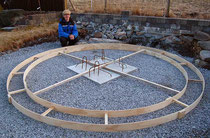Gallery · 30. June 2013
Before the thirty three 16 millimeter bolts are cemented in place, a lot of work is required to make templates. The lower rotation ring comes perforated with more mounting holes than necessary. It is therefore easy to find holes which are located over cavities in the blocks, which will later be filled with concrete.
Gallery · 20. June 2013
Thirty two bolts, cast in concrete, will hold the lower rotation ring in place. The uppermost row of blocks will be filled with concrete.
Gallery · 10. June 2013
The crown, a 12 cm thick ring of reinforced concrete, will cap the top of the masonry. The crown serves two functions: it binds the structure together and it secures thirty-two bolts which hold the dome rotation ring's steel track in place.
Gallery · 28. May 2013
The pole marks the exact center of the cylindrical foundation. Each cinder block is mortared 150 centimeters from this axis, giving an inner diameter of three meters.
Gallery · 20. May 2013
The foundation ring is cast on compressed, crushed granite, which lies in contact with crystalline bedrock. It is fun to balance on it while one skips.
Gallery · 12. May 2013
After careful levelling of the formwork, the concrete ring is finally complete.
Gallery · 26. April 2013
If this mirror blank was on display at a museum of modern art, connoisseurs would think it was an abstract installation. More beautiful, stiffer and lighter mirror blanks do not exist. This is the primary mirror in Norway's largest optical telescope. It is made of Schott borosilicate glass, 620 mm in diameter, 73 mm thick and weighs only 17 kg. Only Dream Cellular, LLC, can produce so lightweight and stiff mirror blanks.
Gallery · 24. April 2013
The concrete formwork for the foundation of the observatory's cylindrical base is now complete. With both internal and external bracing (only internal bracing is shown in the photo to the right), this is a stiff formwork that is very easy to construct. Spacers Wooden spacing rods are fastened with screws between the two plywood rings. These spacers are 25 cm long, forming a concrete ring that is the same width as the cinder blocks. The spacers will be removed when the form is anchored with...
Gallery · 02. April 2013
With an outer diameter of only 3.5 meters, this is a very small observatory for a 62 cm telescope. The cinder blocks have a wide cross section, so the floor space is only around 9 square meters. Unfortunately, I ran out of gravel yesterday. Three more tonnes will be delivered on April 4th. Then I can complete filling, levelling off, and compressing with a vibrating plate. I hope to complete the ground work during the weekend.










